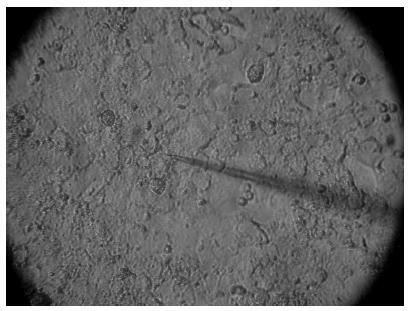Summary
Revista Brasileira de Ginecologia e Obstetrícia. 12-01-2018;40(12):763-770
The aim of the present study was to provide a better understanding of the specific action of two follicle-stimulating hormone (FSH) isoforms (β-follitropin and sheep FSH) on the membrane potential of human cumulus cells.
Electrophysiological data were associated with the characteristics of the patient, such as age and cause of infertility. The membrane potential of cumulus cells was recorded with borosilicate microelectrodes filled with KCl (3 M) with tip resistance of 15 to 25 MΩ. Sheep FSH and β-follitropin were topically administered onto the cells after stabilization of the resting potential for at least 5 minutes.
In cumulus cells, the mean resting membrane potential was - 34.02 ± 2.04 mV (n = 14). The mean membrane resistance was 16.5 ± 1.8 MΩ (n = 14). Sheep FSH (4 mUI/mL) and β-follitropin (4 mUI/mL) produced depolarization in the membrane potential 180 and 120 seconds after the administration of the hormone, respectively.
Both FSH isoforms induced similar depolarization patterns, but β-follitropin presented a faster response. A better understanding of the differences of the effects of FSH isoforms on cell membrane potential shall contribute to improve the use of gonadotrophins in fertility treatments.

Summary
Revista Brasileira de Ginecologia e Obstetrícia. 03-18-2003;24(10):681-684
DOI 10.1590/S0100-72032002001000008
PURPOSE: to assess ovarian function in patients with cervical cancer following radical hysterectomy with ovarian preservation. METHODS: we retrospectively analyzed patients with cervical carcinoma, submitted to radical hysterectomy with ovarian preservation at the Gynecologic Clinic of the São Marcos Hospital-SPCC, from April 1998 to October 2001, with evaluation of symptoms of estrogenic deprivation (flushing, dry vagina) and the measurement of FSH levels after surgery. All data were analyzed using the Pearson test. RESULTS: FSH levels were measured in 42 patients; of these, 33 (78.5%) patients had normal FSH levels (below 30 mU/mL). The median level was 21.05 mU/mL (range 1.2-132.44 mU/mL). Five (55.6%) of the nine patients with high FSH levels had received postoperative radiotherapy (p<0.0001). There was no correlation between postoperative FSH levels and age over 40 years (p=0.33). Benign ovarian cysts occurred in four patients (7.7%). One patient presented recurrence of the lesion in the vaginal dome and metastasis to the scalp, and died. CONCLUSION: in 78.5% of the patients, ovarian function was preserved. Ovarian transposition was inadequate to preserve ovarian function in patients who underwent postoperative radiotherapy. There was no correlation between age and postoperative FSH levels.
Summary
Revista Brasileira de Ginecologia e Obstetrícia. 07-24-2002;24(5):323-327
DOI 10.1590/S0100-72032002000500006
Purpose: to assess ovarian reserve by FSH determination on the 3rd day of the menstrual cycle compared to the clomiphene test and to correlate the results with the ovarian response to controlled hyperstimulation with gonadotrophins for in vitro fertilization. Methods: a total of 49 patients older than 30 years who had been presenting a clinical picture of infertility for at least 1 year were selected. All patients were evaluated for ovarian reserve by the clomiphene citrate test and 26 of them were later submitted to controlled ovarian hyperstimulation with gonadotrophins. Of these 26 patients, 18 showed a good response to ovarian hyperstimulation and 8 showed a poor response. Mean (+ SD) FSH values were calculated for the determinations on the 3rd and on the 10th day and for their sum in the group of patients who responded favorably to ovarian stimulation, and were later correlated with the ovarian response after gonadotrophin stimulation. Results: employing a FSH value > 16.1 IU/mL on the 10th day (mean plus 2 SD) for the prediction of a poor ovarian response in the clomiphene test, the sensitivity, specificity, and positive and negative predictive values of this parameter were 50, 100, 100 and 81.8%, respectively. Considering the clomiphene test to be positive when the sum of the FSH values determined on the 3rd and 10th day plus 2 SD was > 22.6 IU/mL, we obtained 62.5% sensitivity 100% specificity, 100% positive predictive value, and 85.7% negative predictive value. A single FSH determination of 10 IU/mL on the 3rd day of the cycle for the prediction of a poor ovarian response showed 87% sensitivity, 100% specificity, 100% positive predictive value and 94.7% negative predictive value. Conclusion: in the present study, a single FSH determination on the 3rd day of the cycle showed to be more sensitive than the clomiphene test for the evaluation of ovarian reserve.